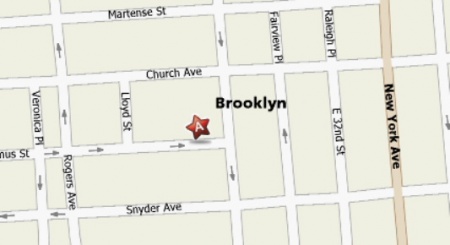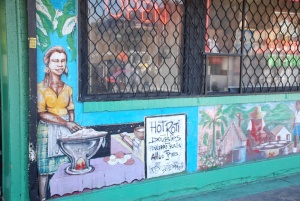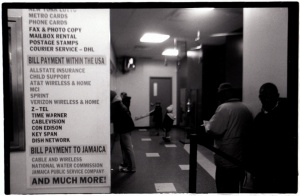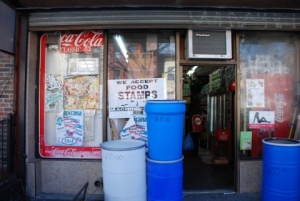Transnationalism and the Businesses of East Flatbush
From Seminar 2: The Peopling of New York City
Contents |
Introduction
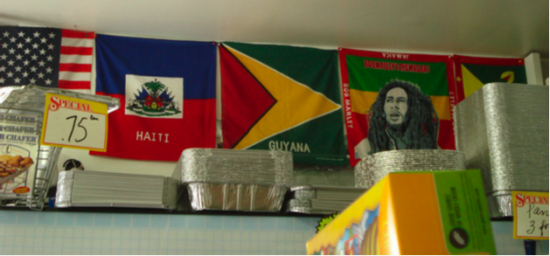
The uncertainty in the small West Indian economies, as well as the draw of the capitalism that defines the American economy has led to the immigration of West Indians to the United States. However, these immigrants have still kept their ties to home through the processes of transnationalism. “Transnationalism has increasingly come to denote the cross-border networks developed by migrants and the ways in which these link geographically distinct places into a single social field” (Trotz 2006, p41). Transnational communities consist of immigrants that identify with more than one locality in the social, cultural, and/or economic spheres. East Flatbush is one of these communities in which the businesses cater to the West Indian transmigrants that live there.
Analysis of the Businesses around the Area
One major shopping area in Flatbush is a five block stretch of Church Avenue between Rogers Avenue and New York Avenue. Although this area cannot be said to be complete illustrations of the whole immigrant neighborhood, it is representative of businesses found in typical West Indian Communities. Moreover, the businesses in the community reflect the culture, economics, and values of the neighborhood of an amazing West Indian mixture. The businesses found in this five block stretch were tallied in order to find out which businesses serviced the transmigrant community. Our findings are posted here.
We counted a total of 95 stores in the area surveyed. Approximately 15 percent of these businesses were beauty oriented, including nail and hair salons, and African hair braiding establishments. Another 15 percent were restaurants, including roti restaurants, bakeries, Chinese restaurants, and franchises such as Golden Krust and McDonalds. Eight percent of the businesses in Flatbush were for entertainment, which included CD, DVD, or book stores, African movie stores, or electronics stores. Other notable businesses included travel agencies, day care centers, and pharmacies, each comprising three percent of the entire pool of businesses. These are only a small sample of the many places that serve the East Flatbush community.
Entrpreneuralism and the Role of the Immigrant Community
In many ways, East Flatbush echoes several other such communities throughout the city such as Chinatown, Flushing and Harlem. Although less well known, it harbors several characteristics that make these places so successful. Firstly, it is the attitude of the people coming to the United States seeking work, and what they want to achieve by it.
What happened is that the West Indians of East Flatbush began to create an immigrant community that caters for their individual needs and feeds on itself and the city’s growing population for a reliable income. It is successful because its residents, mostly all first or second-generation West Indians, have first hand knowledge of the products they are specializing in, described as an ethnic market niche. This can be described as a position in the economic environment where immigrant businessmen and woman have an adaptive advantage over others in their knowledge and experience of what they are involved in. The ethnic community of East Flatbush supports its own economy by providing high demand for goods and services that immigrant businesses are uniquely qualified to provide, because the businessmen and women know the particular tastes and preferences from their homeland (Butler and Kozmetsky). For entrepreneurial business people however, this means a disproportionably high concentration of small businesses in the area.
Many small businesses start using middleman economic policies, hiring people from outside the neighborhood to bring in initial capital and labor to get started. These people generally live in better off neighborhoods, and only come to these places for work, with no real connection to their customers. This can be seen in East Flatbush in the huge corporate franchises such as McDonald’s and Dunkin Donuts, with an almost entirely Indian or Hispanic workforce. However, this comprised only two out of the dozens of stores lining Church Ave and Nostrand. A man working a solo shift at a Caribbean bakery takes orders in a thick Jamaican accent. “Business is up and down,” he says. He moved from Jamaica twenty-two years ago and has lived in Brooklyn for the majority of his life, with no imminent plans on leaving. He has been at the bakery for four years, and says he makes money to support his family in East Flatbush and also sends money to family in Jamaica.
Salons
All of the hair and beauty salons were filled and had a very busy atmosphere. In addition, the sheer number of beauty salons in the neighborhood (12 in those five blocks alone, not including the African hair braiding) shows how important it is to the culture as well as how the businesses are servicing the neighborhood and the transmigrants that live there.
Food
The food of a neighborhood is very important in facilitating transnationalism economically and culturally. The types of food sold is specific to Flatbush and other West Indian transmigrant communities. There are cultural cuisines such as Jamaican restaurants, the many West Indian bakeries (such as Golden Krust), and roti shops. One of the Caribbean restaurants we visited served homemade curry and oxtail as dishes. They mostly had clientele from the neighborhood. This shows that they were servicing the transmigrants living in the community.
In a deli we went into they were selling cultural food of the caribbean such as Goya beans, rice from Haiti, bacalao, curry powder, senna pods, mauby bark, aniseed, cerasse, Roopalee brand, basmati rice, corn meal, and casava. This store was directed toward the transnationals from the West Indies.
Furthermore, the supermarkets in the neighborhood carried West Indian fruits and vegtables in addition to the fruits and vegetables usually found in a supermarket in New York. These included sweet batata, dry coconut, yuca, chayote, gandules, and Costa Rica yams.
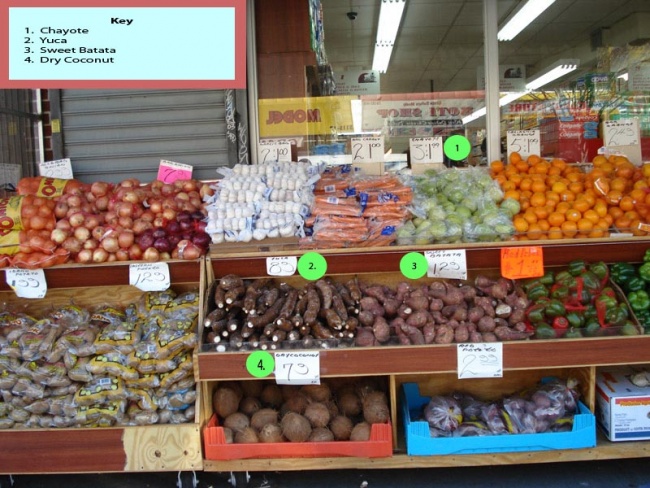
For cultural information on food click here
Music
Music is an integral part of Flatbush business. Cars passed with their windows open, the lively bass of soca and rap music pulsing into the air. One bakery almost sounded like a dance club, as one corner of the store included a vendor selling CDs from various Caribbean and local artists. In a record store on Church Avenue, actual records stood with CDs of Caribbean music on shelves as reggae music played in the store. The varied rhythms of music being played and sold in this area exhibited one of the many goods West Indians in this area purchase that involves their culture. In addition, in may of the shops including a grocery store and an ethnic Jamaican restaurant had pictures of Bob Marley, the music icon, hanging. (For cultural information on music click here)
Some artists being sold in the stores include Morgan Heritage, TOK, Jah Cure, Damian Marley, Sizzla Kalonji;
Transnationalism is present throughout the neighborhood of Flatbush, and permeates through the businesses and the culture. One group mentioned previously even has lyrics in their song that depicts transnational ties:
Just ask about Brooklyn, and how the ganja move in the street
And when your poor you cant sleep
Ask mi bout Brooklyn, where everyday another bites the dust
True so much gunshot a buss
Just ask mi bout Jamaica, where life is gettin harder
And if you ever come on yah
Ask mi bout Jamaica, whether policeman and soldier
Nuh stop charge man fi murda,
“Brooklyn & Jamaica” -Morgan Heritage
Examples of some of the music sold can be found here.
Money Transfer and Barrel Shipping
Money Transfer to the Caribbean
Money transfer companies are abundant in the West Indian neighborhood of Flatbush. In the area we surveyed, there were three money transfer businesses, two of them on the same block. All were busy as customers sent money to locations in the Caribbean. Through the use of money transferring sites, West Indians can send money home to help support their families and pay bills. Some businesses, like Western Union, also offer to pay utility and phone bills directly to companies based in the Caribbean. Many customers prefer going to these Caribbean money transfer agencies, because they find comfort and familiarity in the language spoken by the employees, without any cultural barriers.
Barrel shipping is also a migrant business that plays an important role to both the lives of the Caribbean migrants and folks back home. Many West Indian families send clothing, toiletries, food, and other items back to the Caribbean in barrels. This is another way to support their families financially, as the items they send are more expensive in the Caribbean. Barrel shipping service flourish as a result of the melting down of geographical, economical, and political barriers, and the forming of transnational social relations between two nation-states.
Works Cited
- Islands in the City: "West Indian Migration to New York." Nancy Foner, ed. New York: Columbia University Press.
- Blanc, Cristina Szanton; Linda Basch; Nina Glick Schiller. “Transnationalism, Nation-States, and Culture.” Current Anthropology, Vol. 36, No. 4: 683-686
- Glick Schiller, Nina; Linda Basch; Cristina Szanton Blanc. 1995. "From Immigrant to Transmigrant: Theorizing Transnational Migration." Anthropological Quarterly, Vol. 68, No. 1: 48-63.
- Kearney, M. 1995. “The Local and the Global: The Anthropology of Globalization and Transnatinalism.” Annual Review of Anthropology. Vol 24: 547-565.
- Trotz, D. Alissa. 2006. “Rethinking Caribbean transnational connections: conceptual itineraries.” Global Networks. Vol. 6, No. 1: 41-59.
- Yeung, Henry Wai-chung. 1998. “Capital, State and Space: Contesting the Borderless World.” Transactions of the Institute of British Geographers, New Series. Vol. 23, No. 3: 291-309
- www.mapquest.com
